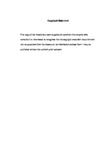The role of environmental temperature in immunocompetence and disease susceptibility in bivalves
| dc.contributor.supervisor | Truebano, Manuela | |
| dc.contributor.author | Mason, George | |
| dc.contributor.other | School of Biological and Marine Sciences | en_US |
| dc.date.accessioned | 2021-10-18T13:47:07Z | |
| dc.date.available | 2021-10-18T13:47:07Z | |
| dc.date.issued | 2021 | |
| dc.identifier | 10521932 | en_US |
| dc.identifier.uri | http://hdl.handle.net/10026.1/18091 | |
| dc.description.abstract |
Disease outbreaks and mass mortality events affecting marine species and ecosystems during periods of high temperature have increased in frequency and intensity over the past several decades. Accordingly, understanding the causes of such thermally-induced outbreaks is increasingly important, particularly in the context of global climate change and predictions of increased pathogen prevalence and disease incidence. Whilst our understanding of immune functions and their adequate energetic provisioning for disease resistance is well developed, little is known on how temperature affects immunological and energetic status in bivalves. Furthermore, even less is known on the potential combined effects between thermal and pathogenic stressors that may further alter host-pathogen dynamics. Consequently, the aim of this thesis was to investigate the individual effects of thermal stress as well as its combined effects with pathogenic challenge on the immunological and energetic condition of bivalves. A rise in temperature from 18 to 21°C caused a significant loss of haemocyte viability (p = < 0.001) in the Pacific oyster, Crassostrea gigas from an average of 80 % to 70 %. Oysters at 21 °C also had a significantly decreased ATP level (p = < 0.001) that fell from an average of 0.78 to 0.51 (µmol g-1). The loss of this immune parameter may indicate stress-induced immunosuppression at higher temperatures, driven by the depletion of this vital cellular biochemical reserve. Exposure of C. gigas to the previously unstudied oyster pathogen, Nocardia crassostreae caused a significant rise in haemocyte counts from an average of 0.623 of to 0.863 (cells 1x106) compared to non-exposed groups. This was associated with a significant loss of glycogen reserves in oysters kept at both 18 and 21 °C, where levels declined from an average of 232 to 105 (µmol g-1) in challenged individuals. Exposure also caused a significant rise in glucose levels (p = 0.002) from an average of 0.34 to 1.42 (µmol g-1) and the total adenylate nucleotides (p = 0.035) from an average of 12.0 to 14.3 (µmol g-1). This suggests that as with other pathogens, oysters may combat N. crassostreae through the mobilisation of energetic reserves and increased glycolytic activity to support the increased metabolic demands of an upregulated immune defence. Overall, this study supports the hypotheses that the suppressive effects of temperature on key immune defences along with the effects of both temperature and pathogen exposure on energy availability may be a factor in influencing disease susceptibility and mass mortalities in oyster populations. In contrast to previous studies, no strong interactive effects between N. crassostreae and temperature were seen on the immunology or energetics of oysters, suggesting the mechanisms that may govern mass mortalities need to be considered individually, based on the host-pathogen model at play. Further, incorporating bioenergetics measurements may prove important in understanding the consequence for host immunity and disease resistance during periods of thermal stress. | en_US |
| dc.language.iso | en | |
| dc.publisher | University of Plymouth | |
| dc.subject | Mass mortalities | en_US |
| dc.subject | Crassostrea gigas | en_US |
| dc.subject | immunology | en_US |
| dc.subject | Nocardia crassostreae | en_US |
| dc.subject | pathogen | en_US |
| dc.subject | energetics | en_US |
| dc.subject.classification | ResM | en_US |
| dc.title | The role of environmental temperature in immunocompetence and disease susceptibility in bivalves | en_US |
| dc.type | Thesis | |
| plymouth.version | publishable | en_US |
| dc.identifier.doi | http://dx.doi.org/10.24382/640 | |
| dc.rights.embargoperiod | No embargo | en_US |
| dc.type.qualification | Masters | en_US |
| rioxxterms.version | NA |
Files in this item
This item appears in the following Collection(s)
-
01 Research Theses Main Collection
Research Theses Main


